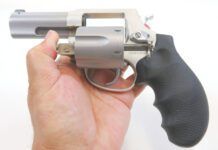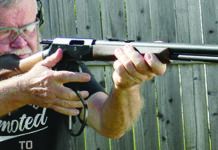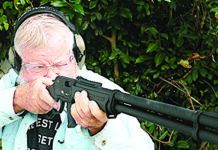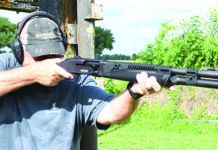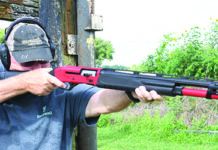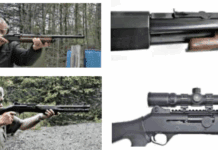
One-piece scope mounts with QD or quick-detachable systems offer a number of advantages over employing two separate rings. The first is strength. Seated in a one-piece mount, the scope itself is no longer a structural component, therefore not subject to undue stress. One-piece scope mounts also do a better job of protecting alignment when the optic spends time away from the rifle, such as when the shooter travels by air or other form of commercial transportation wherein the packed rifle will likely receive indifferent if not rough handling. Quick-detachable systems that do not require tools to remove or replace the scope make the process more convenient. A good-quality one-piece mount should maintain its zero, offering the maximum benefit to the traveling shooter or after having been retrieved from a gunsmith.
In search of a quality one-piece scope mount with QD features, we acquired three such units from Lucid Optics, Sightmark, and Larue Tactical. In addition, these mounts offered a cantilever design that allowed the scope to ride further forward on the receiver. This can be especially helpful when mounted on shorter rifles or carbines where providing proper eye relief can be difficult. Our three scope mounts were the $169 Lucid Optics Pro, Larue’s $232 SPR-E LT139, and SightMark’s $120 Tactical LQD Cantilever Mount. All three were made from aluminum, and each mount was fit with 30mm rings.
How We Tested
We began our tests by mounting each unit on a section of Picatinny rail. We then inserted a pair of Brownells Sleeved Scope Alignment Rods (080-916-000WB, $65). The pointed ends of the rods face-off, with the tips indicating whether the inner diameter of each ring creates one continuous line. We wondered how much variation from perfect we might find and how it would affect the results of our shooting tests.
For a test bed, we turned to one of the higher-quality rifles in our stable. Our 6.5 Creedmoor bolt-action rifle featured a Surgeon action, Bartlein barrel, TriggerTech trigger, and Accuracy International stock built by Strategic Armory Corps (SACFirearms.com). The Surgeon action carried a top-of-the-line Picatinny rail upon which we mounted each unit in turn, holding a Nightforce NXD 3.5-15X50mm scope with Horus H59 reticle. From the 100-yard benches at American Shooting Centers (AMShootCenters.com), our test procedure was as follows. Once zeroed, we removed and replaced the scope and mount units after every three-shot group. This included groups on individual target “dots” mounted side by side and a series of three-shot overlays. By overlay, we mean three shots to a single point of aim, remove and replace the scope/mount unit, and fire three more shots to this same point of aim. What we were looking for was a consistent point of impact no matter how many times the scope was removed and replaced. Tests were repeated 20 times. To ensure consistent accuracy, we relied upon Black Hills 147-grain ELD-M ammunition. Thankfully, the 26-inch-long heavy-contour barrel allowed us to maintain an even barrel temperature and not interfere with results. Durability, deflection of alignment, and ease of application were noted. Let’s see which scope mount brought its “A” game.
| Maker | Lucid Optics | Larue Tactical | SightMark |
|---|---|---|---|
| Item Number | Pro-QD 30mm 677 | SPR-E LT139 | QM34020 |
| Rail | Picatinny | Picatinny | Picatinny |
| Elevation Tested | 0 MOA | 0 MOA | 0 MOA |
| Elevation Available | NA | +20 MOA | +20 MOA |
| Inner Diameter | 30mm | 30mm | 30mm |
| Also Available | NA | 1 in., 34mm, 35mm | 34mm |
| Height Tested | 1.31 in. | 1.5 in. | 1.5 in. |
| Also Available | 1.00, 1.75 in. | NA | NA |
| Extension* | 1.75 in. | 3.75 in. | 3.66 in. |
| Ring Width | 0.66 in. | 0.90 in. | 0.98 in. |
| Ring Spacing** | 3.8 in. | 4.15 in. | 4.12 in. |
| Base Length | 3.25 in. | 4.0 in. | 2.95 in. |
| Overall Length | 4.5 in. | 7.0 in. | 6.0 in. |
| Weight | 7.7 oz. | 7.5 oz. | 7.9 oz. |
| Crossbolt/Lug*** | Crossbolt | Double lug | Crossbolt, single lug |
| Special Features | Bubble level | Interchangeable rings | NA |
| Made In | China | U.S.A. | China |
| Price | 169 | 232 | 120 |
| Website | LucidOptics.com | Larue.com | Sightmark.com |
Larue Tactical SPR-E LT139, $232
Larue currently offers as many as five different extended quick detachable mounts ranging in price from $210 to $232. The primary difference is how far forward the rings are suspended in the cantilever from the base. The $232 SPR-E LT139 offered the greatest amount of extension, making room for the longest of scopes by pushing the rings forward as much as 3.75 inches when measured from the objective ring to the base. Various other models offer less extension as well as greater height above the rail, as much as 1.93 inches. Mounts that add 20-MOA of elevation are also available. Choice of inner-diameter scope rings include 1-inch, 30mm (tested), 34mm and 35mm, and they are interchangeable. The regular price for additional rings is $60.
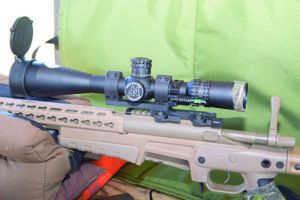
The SPR-E LT139 covered about 4 inches of Picatinny rail but only interfaced with two cross-slots machined side by side in the center of the base. The right-hand side of the base was solid, capturing that side of the Picatinny rail. The left-hand side of the base did not reach under or clamp on to the rail. Instead two cams located about 2.40 inches apart (center to center) cut underneath the rail, pressing when closed against the underside or pitch beneath the Picatinny rail. There was a 3/8-inch hex nut where vertical pressure against the pitch of the rail could be increased. (A tool-less “click adjustable” base has recently been introduced, but to date, with limited cantilever extension.) Only the rearward lever was lockable by sliding outward to release and inward, reducing the overall length of the lever in the lock position. Tension on the hex nut effected ease of operation of the lever, but operation of the lock was not effected by tension adjustment and remained easy to operate.
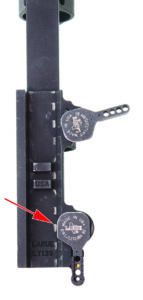
The Larue’s scope rings broke down vertically, splitting from 12 o’clock to 6 o’clock. While the Sightmark mount loaded the scope against a fixed left-side ring, the Larue sandwiched the optic between two separate halves that interfaced with a lug on the base. Perhaps awkward at first, you can begin by setting one side of the ring into the base. For example, viewed from the left-hand side, there is a collar that fits into the base on each ring at the lower right-hand corner. Holding the ring in place, you can insert the scope and then capture it with the opposite half of the ring. It, too, had a collar at lower right that fits into the base. The interior diameters of these collars were threaded. Therefore, you insert the setscrew at lower left on each side. The upper fittings of the rings also had collars that insert and provided threads for the setscrews at upper right on each side. Once assembled, the Larue passed our alignment test.
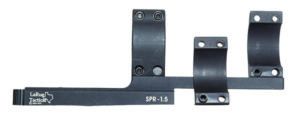
We found that we didn’t need to adjust the tension of cam levers beyond our level of comfort because the distance between the inner edge of the lugs and the rail never changed. We wanted closing the levers to be difficult enough so that no amount of incidental contact would open the front lever. The rear lever remained locked even when we made the action extremely loose. Even with the rear lever unlocked, the two lugs on the underside did not allow for any amount of play once they were settled into the Picatinny rail. At the range we could perceive no amount of measurable deflection in alignment or change in zero over the course of our tests.
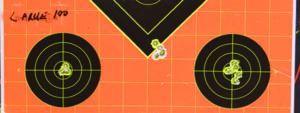
Our Team Said: We think the Larue was the most repeatable of our QD mounts because the dual lugs did not permit forward or rearward movement and the locking system did not rely on lateral pressure. The adjustment of tension was primarily vertical, changing how much force was applied to pressing the mount into the receiver rail. The ability of the mount to maintain zero was perfect, in our view. This mount stood beyond its competitors in this test and is probably as good or better than other high-quality rings. Our staff said they’d buy the base and update with different-size rings if needed.
GUN TESTS GRADE: A
Lucid Optics Pro-QD 30mm Medium Mount No. 677, $170
The Lucid Optics Pro scope mounts are a new product designed to fit riflescopes with a main tube measuring 30mm in diameter. Only the 30mm version is available. This may change in the near future, but LucidOptics.com does offer this unit in three different heights, raising the scope 1.31 inches, 1.75 inches, and 1.93 inches from the base. Our other test mounts offered 1.5 inches of lift. The rings split off at the top radii and were affixed by four 0.66-inch-long Torx screws with T15 heads. The Lucid Optics Pro weighed 7.0 ounces.
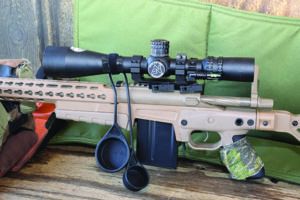
There was a small blue bubble level integrated into the top of the rear scope ring. Measured from their outer wall, the rings were 3.8 inches apart. Production is currently in China, but reportedly will be moving to the Riverton, Wyoming plant by year’s end. The Lucid Optics Pro passed our alignment test.
The Pro series mount covered about 3.0 inches of Picatinny rail and pushed the scope forward about 1.75 inches from its forwardmost crossbolt. The unit indexes on two crossbolts spaced about 1.95 inches apart center to center. Before cinching down, there was just a hint of play front to back. The right side of the mount was solid. The left side provided the quick-release feature by floating a single full-length mounting plate outward on two springs. The left-side rail is then drawn tight laterally by two camming levers that were rotated from perpendicular to the rail to parallel and locked into place.
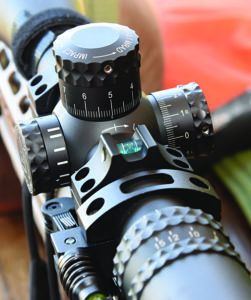
Spring-loaded tabs located atop each lever must be pressed downward independently to release the unit. The crossbolts were threaded on the right-hand side and affixed with hex nuts that were captured by a relief in the lower mount plus a pair of Allen screws. Turning the hex nuts located on the opposite end of the shaft determined how much pressure was applied to grip the rail. This also affected the amount of effort it took to operate the levers. For adjustment, we opened the levers and pushed them inward so that the hex nuts were pulled away from the unit and rotated them 1/6th turn at a time.
Our most consistent results were achieved when the locking nuts were set to provide the greatest amount of tension and still allow for the lever to close down and lock into place. About one-third of our targets indicated no change in point of impact whatsoever after removing and replacing the scope when mounted in the Lucid Optics Pro. The remaining groups spread laterally up to about 0.5 inches from original point of aim at 100 yards.
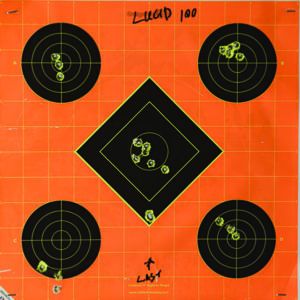
Our Team Said: Factoring in shooter error and changes in conditions, a deflection of 0.6 inches or less is a pretty good showing. The Lucid Pro was the most convenient and easy to use of our three scope mounts, nicely finished and good looking, too. The availability of different bore-to-scope heights was also welcome because most one-piece units limit elevation to 1.5 inches. The blue-colored level in the rearward ring was a nice feature, but it was small and not as easily visible as we would have liked. Without calibration on the hex nut, it was difficult to maintain or record settings. Tension could be skewed while the unit was in the release position should the lever side be pressed and the hex nut turned incidentally. No means of torque rating was possible because the only turning element, the hex nuts, must remain stationary. A tight fit was trial and error.
GUN TESTS GRADE: B+
SightMark Tactical LQD Cantilever Mount M34020, $120
The SightMark unit pushed our scope 3.6 inches beyond its base, which covered about 2.95 inches of rail. The unit indexed on a solid lug located between the crossbolts. The crossbolts were also squared to fit the rail slots, but about 20% of their lengths were left round to facilitate application and adjustment of the quick-release mechanism. Similar to the Lucid Optics Pro, we rotated the levers located on the left-hand side rearward from perpendicular to parallel with the bore to lock the unit in place. But this time, the release for each lever consisted of a latch that was slid toward the rear rather than pressed downward. Operation proved balky. Contact with the rail was split into two sections beneath the corresponding clamps instead of one continuous rail front to back.
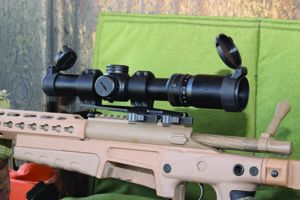
Tension adjustment mirrored the Lucid Pro. Set the compression lever in the release position, push inward and turn the fitting clockwise for additional pressure or counterclockwise to loosen. The fittings on the right side were finger wheels with grooves that were indexed by a steel pin located at approximately 3 o’clock. With 14 grooves to choose from, tension adjustment on this unit was more refined than the six flats of a hex nut as found on the Lucid Optics Pro. But, again, none of the grooves were marked, so keeping track of the adjustment was haphazard even if we felt this design was perhaps less vulnerable to being turned accidentally than the Lucid Pro.
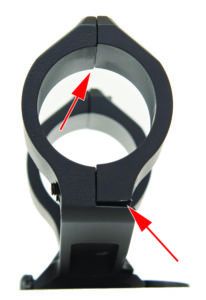
Sightmark offers this unit with either 30mm or 34mm (SM34023) rings. Mounts that add 20 minutes of angle (MOA) of elevation are also available. Our 30mm model with standard elevation (+0 MOA) weighed 7.9 ounces. The rings split off vertically with the right-hand side machined as one piece with the base. Four Torx screws with T10 heads held the rings together. In our alignment test, we found just the slightest variation, off by maybe the gauge of the very tip of the alignment rod itself. When the rings were locked down without a scope in place, the right side of the ring was markedly out of line. We think a true 30mm-diameter circle was achieved only when the rings were relieved to accommodate the scope tube, but none of our other mounts exhibited this aberration. The outer dimensions of the rings did not truly match either, but at least we found it easy to apply the scope. Holding the scope into the left side, we simply closed the door, so to speak, with the right-side halves of the rings and tightened them down. At the range, we saw a variation of windage between applications ranging from 0.40 inches to 0.70 inches for all groups fired.
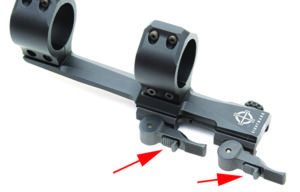
Our Team Said: The SightMark Tactical LQD Cantilever Mount offered the right amount of relief that would make it a useful mount for shorter rifles and carbines. The finger-wheels system made fine adjustment simple, although some form of calibration would have been helpful. We think the slide locks on the release levers were less vulnerable to incidental contact, but they could be difficult to operate. The forward slide lock often forced us to use a gloved hand to operate. Therefore, the advantage of tool-less access was, in our view, all but lost. The amount of windage we had to correct between dismounts was such that there was little, if any, advantage over utilizing an average pair of scope rings.
GUN TESTS GRADE: B
Written and photographed by Roger Eckstine.




